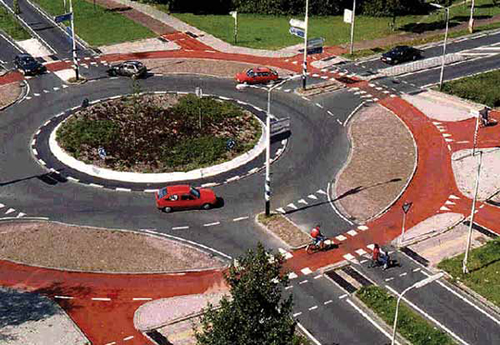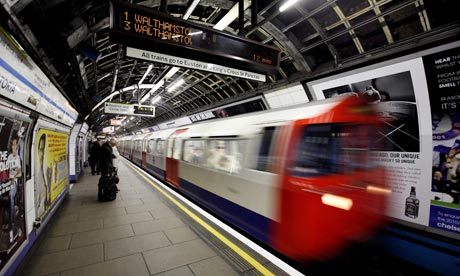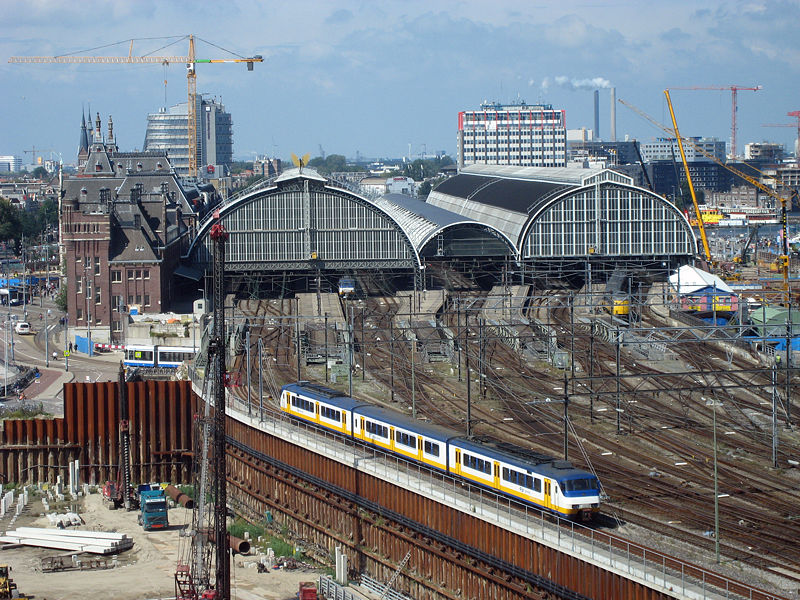Difference between revisions of "Transport Infrastructure"
| (84 intermediate revisions by 6 users not shown) | |||
| Line 1: | Line 1: | ||
| + | [[Category:Mobility]][[Category:Urban object]] |
||
| − | Infrastructure is basic physical and [http://en.wikipedia.org/wiki/Organization organisational] structures needed for the operation of a [http://en.wikipedia.org/wiki/Society society] or [http://en.wikipedia.org/wiki/Business enterprise], or the services and facilities necessary for an [http://en.wikipedia.org/wiki/Economy economy] to function. It can be generally defined as the set of interconnected structural elements that provide framework supporting an entire structure of development. |
||
| ⚫ | '''Transport infrastructure''' consists of the fixed installations necessary for transport and includes [http://en.wikipedia.org/wiki/Road roads], [http://en.wikipedia.org/wiki/Railway railways], [http://en.wikipedia.org/wiki/Airway_(aviation) airways], [http://en.wikipedia.org/wiki/Waterway waterways], and terminals. |
||
| − | |||
| − | The term typically refers to the technical structures that support a society, such as [http://en.wikipedia.org/wiki/Road roads], [http://en.wikipedia.org/wiki/Water_supply water supply], [http://en.wikipedia.org/wiki/Sewage sewers], [http://en.wikipedia.org/wiki/Electrical_grid electrical grids], [http://en.wikipedia.org/wiki/Telecommunication telecommunications], and so forth, and can be defined as "the physical components of interrelated systems providing commodities and services essential to enable, sustain, or enhance societal living conditions." |
||
| − | |||
| ⚫ | |||
== Roads == |
== Roads == |
||
A road is a paved surface to facilitate the movement of people or goods with [#_Road_transport road transport] means, such as as [http://en.wikipedia.org/wiki/Automobile automobiles], [http://en.wikipedia.org/wiki/Bicycles bicycles], [http://en.wikipedia.org/wiki/Buses buses], vans or [http://en.wikipedia.org/wiki/Truck trucks]. |
A road is a paved surface to facilitate the movement of people or goods with [#_Road_transport road transport] means, such as as [http://en.wikipedia.org/wiki/Automobile automobiles], [http://en.wikipedia.org/wiki/Bicycles bicycles], [http://en.wikipedia.org/wiki/Buses buses], vans or [http://en.wikipedia.org/wiki/Truck trucks]. |
||
| − | Roads |
+ | Roads in itself are not an interesting security target, but blocking a road will cause problems with the traffic flow and reachability of certain parts of the city or area. This can be prevented by designing a [#_Robustness robust road system] and to detect a disruption and minimize the consequences, using [#_Traffic_monitoring monitoring] and [#_Traffic_management_1 traffic management]. |
== Rails == |
== Rails == |
||
| − | Rails are the infrastructure for [#_Rail_transport rail transport]. |
+ | Rails are the infrastructure for [[#_Rail_transport| rail transport]]. A rail road which connects two locations is also called a rail line. |
| − | As for roads, rails on itself are not an interesting security target, but blocking a railroad will cause large problems with the rail transport. |
+ | As for roads, rails on itself are not an interesting security target, but blocking a railroad will cause large problems with the rail transport. |
== Pedestrian / Bicycle paths == |
== Pedestrian / Bicycle paths == |
||
| − | Insert text |
||
| + | [[File:Bikepath.jpg|thumb|right|300px|Delineated bicycle and pedestrian paths at roundabouts in The Netherlands]] |
||
| ⚫ | |||
| + | Pedestrian paths or sidewalks, curbs, pavements, footpaths or platforms are paths alongside a road designated for pedestrians. Bicycle paths comprises of several different forms of cycling infrastructure, from non-segregated pathways aligned next to the road to segregated cycle facilities. |
||
| − | Insert text |
||
| + | |||
| + | Segregated cycle facilities are a form of cycling infrastructure consisting of marked lanes, tracks, shoulders and paths designated for use by cyclists and from which motorised traffic is generally excluded. The term includes bike lanes, cycle tracks, separated bike lanes, road shoulders and side paths located within a road right-of-way<ref>From: http://en.wikipedia.org/wiki/Segregated_cycle_facilities#Bikeways_that_use_independent_rights-of-way. Retrieved on April 5, 2012</ref>. |
||
| + | |||
| ⚫ | |||
| + | Inter and intra urban transport over waterways such as canals, rivers or other waterways forms a smaller although still important aspect of the [[Transportation system|urban transport system]]. For port cities such as Rotterdam, Antwerp or Hamburg the waterway system is of vital importance for their [[Economic impact|economic development]]. |
||
== Subway system == |
== Subway system == |
||
| + | [[File:London-Underground-006.jpg|thumb|right|300px|London Underground station]] |
||
| − | Insert text |
||
| + | A rapid transit, underground, subway, elevated railway, metro or metropolitan railway system is an electric passenger railway in an urban area with a high capacity and frequency, and grade separation from other traffic. Rapid transit systems are typically located either in underground tunnels or on elevated rails above street level<ref>http://en.wikipedia.org/wiki/Subway_(rail)</ref>. |
||
== Bridges and fly-overs == |
== Bridges and fly-overs == |
||
| + | A bridge is a structure built to span physical obstacles such as a body of water, valley, or road, for the purpose of providing passage over the obstacle<ref>From: http://en.wikipedia.org/wiki/Bridge. Retrieved on April 5, 2012</ref>. A flyover is a bridge, road, railway or similar structure that crosses over another road or railway forming a grade separation<ref>From: http://en.wikipedia.org/wiki/Bridge. Retrieved on April 5, 2012.</ref>. Various different designs are possible depending on the length of the span and the conditions of the site. |
||
| − | Insert text |
||
| + | |||
| + | Bridges and fly-overs form a vital and vulnerable element of a transport system since blocking can cause serious disruptions in the transportation system. Security risks are high since bridges and fly-overs are generally difficult to reach in case of emergencies. |
||
== Terminals == |
== Terminals == |
||
| + | A terminal is any location where freight and passengers either originates, terminates, or is handled in the transportation process. Terminals are central and intermediate locations in the movements of passengers and freight. They often require specific facilities and equipment to accommodate the traffic they handle<ref>The Geography of Transport Systems, Jean-Paul Rodrigue, Claude Comtois and Brian Slack (2009), New York: Routledge, 352 pages. ISBN 978-0-415-48324-7. http://people.hofstra.edu/geotrans/index.html</ref>.<br /> |
||
| − | A terminal is ...<br /> |
||
Terminals may be used both for interchange of passengers and cargo. |
Terminals may be used both for interchange of passengers and cargo. |
||
| Line 38: | Line 42: | ||
=== Airports === |
=== Airports === |
||
| + | An airport is a location where aircraft such as fixed-wing aircraft, helicopters, and blimps take off and land. Aircraft may be stored or maintained at an airport. An airport consists of at least one surface such as a runway for a plane to take off and land, a helipad, or water for takeoffs and landings, and often includes buildings such as control towers, hangars and terminal buildings<ref>http://en.wikipedia.org/wiki/Airport</ref>. |
||
| − | Insert text |
||
=== Train station === |
=== Train station === |
||
| + | A train station, also called a railroad station (mainly in the United States) or railway station (mainly in the British Commonwealth) and often shortened to just station, is a railway facility where trains regularly stop to load or unload passengers or freight. It generally consists of a platform next to the track and a station building (depot) providing related services such as ticket sales and waiting rooms<ref>http://en.wikipedia.org/wiki/Train_station</ref>. |
||
| − | Insert text |
||
| + | |||
| + | [[File:Amsterdam centraal side.jpg|thumb|right|300px|Amsterdam Central Station in The Netherlands.]] |
||
| + | |||
| + | === Metro station === |
||
| + | A [http://en.wikipedia.org/wiki/Metro_station metro station] or subway station is a railway station for a rapid transit system, often known by names such as "metro", "underground" and "subway". |
||
| + | |||
| + | Metro stations are very vulnerable for terrorist attacks, as can be seen from this list with underground attacks [http://en.wikipedia.org/wiki/Attacks_on_the_London_Underground attacks on the London underground]. |
||
=== Bus terminal === |
=== Bus terminal === |
||
| + | A bus terminus is a designated place where a bus or coach starts or ends its scheduled route . |
||
| − | Insert text |
||
=== Freight terminal === |
=== Freight terminal === |
||
| + | A freight terminal is a processing node for freight. Most freight terminals are located at ports. They may include airports, seaports, railroad terminals, and trucking terminals. Freight is usually loaded onto and off the transport<ref>http://en.wikipedia.org/wiki/Freight_terminal</ref>. |
||
| − | Insert text |
||
| − | === |
+ | === Sea port === |
| + | A sea port (or shortly port) is a location on a coast or shore containing one or more harbours where ships can dock and transfer people or cargo to or from land<ref>http://en.wikipedia.org/wiki/Port</ref>. |
||
| − | Insert text |
||
== Traffic intersections == |
== Traffic intersections == |
||
| Line 61: | Line 72: | ||
Possible measures to prevent attacks at important intersections are monitoring with cameras and providing sufficient route alternatives. |
Possible measures to prevent attacks at important intersections are monitoring with cameras and providing sufficient route alternatives. |
||
| + | ==Related subjects== |
||
| − | == Criticality of infastructure == |
||
| + | * [[Critical infrastructure|Critical infrastructure (protection)]] |
||
| − | |||
| − | === General === |
||
| − | Insert text. |
||
| − | |||
| − | === Perception of criticality === |
||
| − | |||
| − | The systematic analyses of citizens' perceived criticality of infrastructure and neces-sity to protect it is an essential component for the determination of security demands as a public good, also as related to strategic urban planning. A state of the art review leads to the following indicators for citizens’ subjective needs to provide for protection of critical infrastructure, as well as of their over-perception or under-perception of the criticality of that infrastructure.<ref>CF. results from the project SFI@SFU: "Development of an Austrian Centre for Comprehensive Security Research at Sigmund Freud Private University Vienna" (http://www.sfi-sfu.eu) in the Austrian national security research programme KIRAS, funded by the Austrian Ministry of Technology, Transport and Innovation (bmvit); project deliverable 2.3: ''Integrierte Risikobewertungssystematik (comprehensive risk assessment) und subjektive Schutzbedürfnisbewertung für kritische Infrastruktur'' (not published), p. 98</ref>. Knowledge of such kind can for example help urban planners to design in protective measures that not only reflect objective vulnerability but also citizens’ security cultures. Thus, public support for urban planning that is conscious of security aspects can be enhanced and citizens’ acceptance of resulting built infrastruc-ture enhanced. |
||
{{references}} |
{{references}} |
||
Latest revision as of 16:34, 10 December 2015
Transport infrastructure consists of the fixed installations necessary for transport and includes roads, railways, airways, waterways, and terminals.
Contents
Roads
A road is a paved surface to facilitate the movement of people or goods with [#_Road_transport road transport] means, such as as automobiles, bicycles, buses, vans or trucks.
Roads in itself are not an interesting security target, but blocking a road will cause problems with the traffic flow and reachability of certain parts of the city or area. This can be prevented by designing a [#_Robustness robust road system] and to detect a disruption and minimize the consequences, using [#_Traffic_monitoring monitoring] and [#_Traffic_management_1 traffic management].
Rails
Rails are the infrastructure for rail transport. A rail road which connects two locations is also called a rail line.
As for roads, rails on itself are not an interesting security target, but blocking a railroad will cause large problems with the rail transport.
Pedestrian / Bicycle paths
Pedestrian paths or sidewalks, curbs, pavements, footpaths or platforms are paths alongside a road designated for pedestrians. Bicycle paths comprises of several different forms of cycling infrastructure, from non-segregated pathways aligned next to the road to segregated cycle facilities.
Segregated cycle facilities are a form of cycling infrastructure consisting of marked lanes, tracks, shoulders and paths designated for use by cyclists and from which motorised traffic is generally excluded. The term includes bike lanes, cycle tracks, separated bike lanes, road shoulders and side paths located within a road right-of-way[1].
Urban waterways
Inter and intra urban transport over waterways such as canals, rivers or other waterways forms a smaller although still important aspect of the urban transport system. For port cities such as Rotterdam, Antwerp or Hamburg the waterway system is of vital importance for their economic development.
Subway system
A rapid transit, underground, subway, elevated railway, metro or metropolitan railway system is an electric passenger railway in an urban area with a high capacity and frequency, and grade separation from other traffic. Rapid transit systems are typically located either in underground tunnels or on elevated rails above street level[2].
Bridges and fly-overs
A bridge is a structure built to span physical obstacles such as a body of water, valley, or road, for the purpose of providing passage over the obstacle[3]. A flyover is a bridge, road, railway or similar structure that crosses over another road or railway forming a grade separation[4]. Various different designs are possible depending on the length of the span and the conditions of the site.
Bridges and fly-overs form a vital and vulnerable element of a transport system since blocking can cause serious disruptions in the transportation system. Security risks are high since bridges and fly-overs are generally difficult to reach in case of emergencies.
Terminals
A terminal is any location where freight and passengers either originates, terminates, or is handled in the transportation process. Terminals are central and intermediate locations in the movements of passengers and freight. They often require specific facilities and equipment to accommodate the traffic they handle[5].
Terminals may be used both for interchange of passengers and cargo.
Examples of passenger terminals are airports, railway stations and bus stations.
Examples of terminals for cargo are warehouses, trucking terminals, refueling depots (including fueling docks and fuel stations), and seaports.
All terminals are important for security, since it are potential targets for terrorists. Damage will have a big impact, both economically, life danger of people and by hampering the transportation process heavily. Therefore it is recommended to have an extensive and robust transportation system towards and from the terminal and to locate terminals outside urban areas.
Airports
An airport is a location where aircraft such as fixed-wing aircraft, helicopters, and blimps take off and land. Aircraft may be stored or maintained at an airport. An airport consists of at least one surface such as a runway for a plane to take off and land, a helipad, or water for takeoffs and landings, and often includes buildings such as control towers, hangars and terminal buildings[6].
Train station
A train station, also called a railroad station (mainly in the United States) or railway station (mainly in the British Commonwealth) and often shortened to just station, is a railway facility where trains regularly stop to load or unload passengers or freight. It generally consists of a platform next to the track and a station building (depot) providing related services such as ticket sales and waiting rooms[7].
Metro station
A metro station or subway station is a railway station for a rapid transit system, often known by names such as "metro", "underground" and "subway".
Metro stations are very vulnerable for terrorist attacks, as can be seen from this list with underground attacks attacks on the London underground.
Bus terminal
A bus terminus is a designated place where a bus or coach starts or ends its scheduled route .
Freight terminal
A freight terminal is a processing node for freight. Most freight terminals are located at ports. They may include airports, seaports, railroad terminals, and trucking terminals. Freight is usually loaded onto and off the transport[8].
Sea port
A sea port (or shortly port) is a location on a coast or shore containing one or more harbours where ships can dock and transfer people or cargo to or from land[9].
Traffic intersections
At traffic intersections, a certain type of traffic infrastructure is intersecting. Mostly this concerns road intersections, though also rail and air intersections are possible.
To prevent incidents at road intersections, the traffic can be controlled with traffic signals.
Traffic intersections are an attractive target for terrorists, since damaging an intersection has larger consequences in terms of disrupting the traffic flow and number of possible injuries than for a road segment.
Possible measures to prevent attacks at important intersections are monitoring with cameras and providing sufficient route alternatives.
Related subjects
Footnotes and references
- ↑ From: http://en.wikipedia.org/wiki/Segregated_cycle_facilities#Bikeways_that_use_independent_rights-of-way. Retrieved on April 5, 2012
- ↑ http://en.wikipedia.org/wiki/Subway_(rail)
- ↑ From: http://en.wikipedia.org/wiki/Bridge. Retrieved on April 5, 2012
- ↑ From: http://en.wikipedia.org/wiki/Bridge. Retrieved on April 5, 2012.
- ↑ The Geography of Transport Systems, Jean-Paul Rodrigue, Claude Comtois and Brian Slack (2009), New York: Routledge, 352 pages. ISBN 978-0-415-48324-7. http://people.hofstra.edu/geotrans/index.html
- ↑ http://en.wikipedia.org/wiki/Airport
- ↑ http://en.wikipedia.org/wiki/Train_station
- ↑ http://en.wikipedia.org/wiki/Freight_terminal
- ↑ http://en.wikipedia.org/wiki/Port


